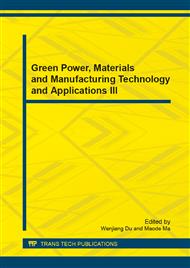[1]
Yu Liandong. The distribution and development of heavy oil around the world . Special Oil & Gas Reservoirs, 2001, 8(2): 98-99.
Google Scholar
[2]
Yang Shengli, Geng Lifeng. The application steam huff and puff in super heavy oilfield . Special Oil & Gas Reservoirs, 2002, 9(6): 16-17.
Google Scholar
[3]
Dou Hongen. The discussion of Heavy Oil Thermal Recovery using SAGD technology . Petroleum Technology Forum, 2003(4): 50-53.
Google Scholar
[4]
Zhang Rui. The technology of Heavy Oil Thermal Recovery . Beijing: Petroleum Industry Press, (1999).
Google Scholar
[5]
Liu Shangqi, Bao Lianchun, Ma Desheng. New Technology study for the development of a supper-heavy oil reservoir in Liaohe oil field. PETROLEUM EXPLORATIONAND DEVELOPMENT, 1999, 26(4): 80-81.
Google Scholar
[6]
Zhang Yitang, etal. The technology of Heavy Oil Thermal Recovery . Petroleum Technology Forum, (2006).
Google Scholar
[7]
Hu Xingzheng. Experimental study on converting to steam flooding after cyclic steam stimulation for Du229B lock in Shuguang Oilfield . Special Oil and Gas Reservoirs, 2009, 16(5): 62-63.
Google Scholar
[8]
Shi Xiaoqu, etal. The analysis of converting steam huff and puff to water flooding in Heavy Oil Field. Henan Petroleum, 2004, 18(Supplement): 44-45.
Google Scholar
[9]
Lv Xiaoguang, etal. Reservior Geologic Model and Random Modeling Technique. Petroleum Geology & Oilfield Development in Daqing, 2000, 19(1): 10-13, 16.
Google Scholar
[10]
Xing Yuzhong, Yan Qibin, YangHuiting. Application OF Stochastic Modeling Technology IN Detailed Reservoir Description—Taking a Fault Block of Dagang Oilfield as example. NATURAL GAS EXPLORATION&DEVELOPMENT, 2006, 29(3): 42. 45.
Google Scholar
[11]
Wu Xingbao, Li Shaohua, Yin, etal. Application of facies-controlled stochastic modeling in heterogeneity study. FAULT-BLOCK OIL & GAS FIELD, 2009, 16(2): 58-60.
Google Scholar
[12]
Song Kaoping, Song Hongcai, Wu Wenxiang. The theory of Numerical Simulation . Beijing: Petroleum Industry Press, 1996: 23-26.
Google Scholar
[13]
ZhaoQishuang, SunYan, GuoFujun. A Method OF Forecasting Heavy Crude Reservoir Performance Indexes During the huff and puff Process. ACTA PETROL EI SINICA. 1996, 17(2): 47-52.
Google Scholar
[14]
Butler R M. Steam-assisted gravity drainage: concept, development, performance and future. JCPT, Feb. 1994, 44~55.
Google Scholar
[15]
Stang HR and Soni Y. The Saner ranch pilot fracture-assisted steam flooding. SPE 10707.
Google Scholar


